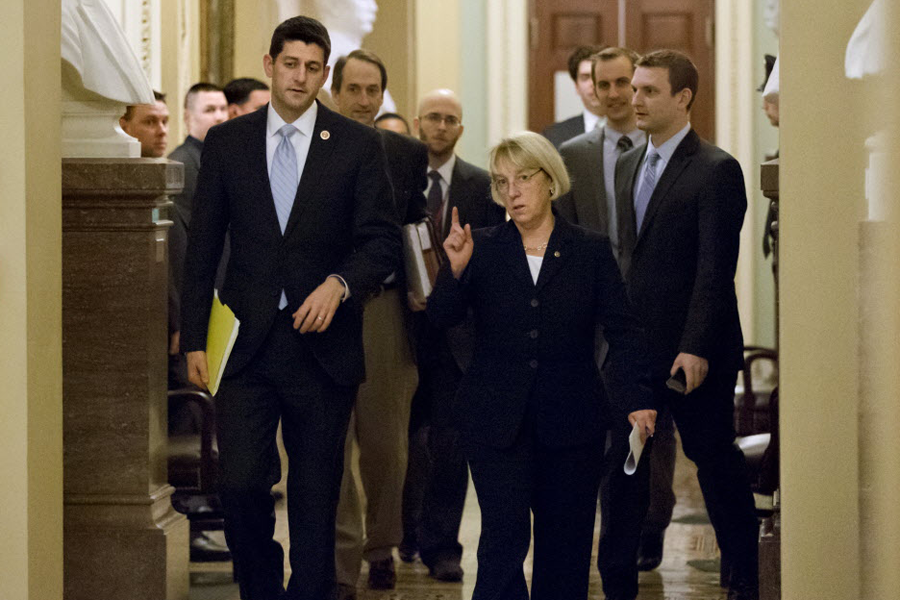No ‘grand bargain’ in budget deal: What does that mean for the economy?
Loading...
| Washington
The accord reached between bipartisan negotiators this week is a budget “mini-deal.” If it’s approved by the House and Senate, the good news is simply that there is a deal to fund the federal government – no shutdowns or Main Street worries about budget chaos in Washington.
The not-so-good good news: the agreement doesn’t make meaningful strides toward controlling the expected rise of the national debt.
And there doesn’t seem to be any appetite among Republicans and Democrats to seek such a deal prior to the 2014 elections.
So, is this deal a good one for Americans and their economy?
Yes, in one narrow but important sense: Many budget experts say the modest deal is better than none at all. It could pave the way for more good-faith bargaining. It promises to boost next year’s gross domestic product (GDP), forecasters say. And it replaces some of the random cuts embedded in a 2011 “sequester” with spending plans that may be more palatable to both parties.
The larger answer, though, is a more complex story. Many economists say Congress could do more with fiscal policy to promote economic growth, to reduce unemployment, and to control what are widely viewed as unsustainable federal deficits.
Congress can postpone a grand bargain that reforms the tax code and restrains the growth of entitlement spending, and the economy won’t collapse.
But delay isn’t a good thing for the economy.
“Waiting to enact long-term reforms will not only increase the amount of deficit reduction necessary, but will make it more difficult to achieve,” the nonpartisan Committee for a Responsible Federal Budget warns in a recent report. “Enacting policies today would allow policies to be phased in gradually, which would not only be more politically viable but also give the public and the economy time to adjust to any changes.”
The group, which has former Democratic and Republican lawmakers as directors, estimates that Congress needs to reduce cumulative deficits over the next decade by $2.2 trillion to bring the national debt under control. And some $13 trillion in deficit cuts would be needed, over two decades, to actually steer the debt on a downward path as a share of GDP.
By comparison, the new budget compromise worked out by Rep. Paul Ryan (R) and Sen. Patty Murray (D) would reduce deficits by $85 billion over the next decade, according to Congressional Budget Office estimates. In other words, the accord barely puts a down payment toward the long-term challenge.
Economists are divided over the best course for fiscal policy, not just because of partisan viewpoints but also because the decisions aren’t easy.
Debt is already historically high as a share of GDP, and the prospect of an ongoing rise in public-sector borrowing poses a threat to economic growth over the long run. But in the near term, the big challenge facing the economy is too many people without jobs.
The Congressional Budget Office (CBO) has laid out both challenges.
“Lawmakers face difficult trade-offs when deciding how quickly to carry out policy changes that would make the path of federal debt more sustainable,” Douglas Elmendorf, the current CBO director, said at a recent conference.
He proposed a strategy that’s shared by many other economists: imposing less fiscal tightening (such as spending cuts) in the near term “but greater tightening in later years.”
The tightening, many argue, should focus on the portions of the budget where spending is forecast to rise the most: health-care entitlements and Social Security. Making those programs fiscally sustainable could include a blend of spending cuts and tax hikes, not just one or the other.
In other words, there’s lots of room here for bipartisan compromise, if the two sides can draw some inspiration from their latest agreement. And there’s lots of room for disagreement, of course, as neither tax hikes nor benefit cuts in programs like Social Security tend to be popular.
Already, the mini-budget deal travels the path of “spend more now, tighten later,” in a very modest way. Federal spending would be higher in 2014 and 2015 than under the sequestration status quo. The change would be paid for in part by imposing some additional spending cuts that wouldn’t hit home until 2022 and 2023.
As the CBO and other mainstream economists see it, that means modestly stronger growth and more jobs in the economy in the near term.
But in the longer run, their budget deal doesn’t change the outlook for national debt to remain high and ultimately start rising again. The debt burden, forecasters say, means Americans would see slower gains in income until the problem is addressed. Growth would be crimped and the nation would be more poorly positioned to deal with financial emergencies.
Another problem: As entitlements and related interest on the debt eat up an ever-larger share of the federal budget, it leaves less room for investments that might buoy economic growth.
The congressional negotiators went small because they’ve found it so politically hard to go big. But the economy may be paying a price.








